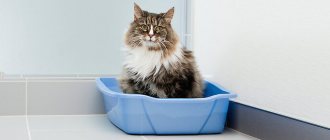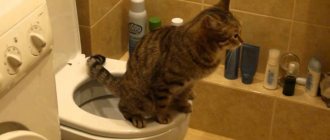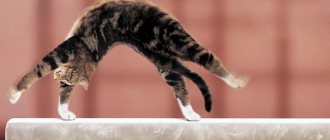When a kitten appears in an apartment, most people teach it to use a litter box, which involves constant cleaning, time and material costs. Therefore, many breeders initially raise their pets differently.
At first glance, it seems that only a trainer can train a cat to use the toilet. In fact, you can do this yourself, just be patient, treat your animal with love, and soon your four-legged friend will please the owner with his first successes.
Wrong opinion
Experts say that it is necessary to accustom your pet to the toilet from infancy, because it is impossible to accustom an adult cat. They also say that a litter box trained kitten will not change its habit. This is incorrect for several reasons:
- for the first six months of a kitten’s life, you cannot accustom it to the toilet, because it will not be able to hold steady, it will get scared and will avoid this place;
- first, accustom the pet to the tray;
- Even an adult cat can be toilet trained.
Each animal has its own character, one is easy to train, the other, due to fear and apprehension, needs more time to get used to. The approach to each kitten should be individual, but the principle of training is no different. First, you need to teach your pet to masterfully use the litter box.
CitiKity simulator
The essence of this simulator is that it includes plastic in the form of a tray and there are 7-8 sections on it. That is, the question of how to train a cat to pee on the toilet can be resolved in 7-8 weeks. This tray should be placed under the baby cat and covered with cat sand, and then left there for a week.
You need to train the cat to jump in there. After a week, you need to cut out the first section - the smallest circle that is in the middle. The cat continues to get used to walking.
- After a week, cut out even more. Eventually, when there are no sections left at all, you will end up with a healthy hole. Thus, the animal learns to relieve itself in the toilet on its own. If you teach it from two months, it takes about a year and a half.
- The instructions say that you can train from 6 months, but the sooner you do this, the better, because the older the cat gets, the more difficult it is to influence him.
- During this time, there will be cases when the cat will go the wrong way, relieve itself in all corners, for which it needs to be punished. This punishment lasts for a week, after which everything is repeated, but patience is important here.
- Teaching a cat to go to the toilet is not an easy job, but at the same time, it is an opportunity to study his habits, character, and behavior.
In the future, the owner will already know that if a cat, for example, rushes around the apartment and meows loudly, this means that he wants it big. If he starts clinging to the carpet with his paws and spinning around the wall, it means that he wants something small.
Let's start with the tray
It is necessary to accustom your baby to the tray from the first days after birth. Kittens have a peculiarity - they defecate immediately after eating. If you are patient and make sure that your baby goes to the toilet immediately after eating for several days in a row, then your pet will not have problems with the toilet in the future.
The cat must be handled carefully, without causing pain. When the kitten has eaten, carefully pick it up under the tummy and take it to the tray. If the kitten crawls out of the toilet without emptying itself, it is returned back. After completing toilet chores, the kitten is praised.
The toilet container is placed in a convenient place; sometimes the kitten itself will determine such a place, trying to empty itself there. Then the tray is gradually moved closer to the toilet room.
First, the cat is accustomed to the sound of water pouring out of the cistern. They do this gradually, drain the water with the door open so that the cat hears the noise from afar, then press the drain in front of the animal. While the water is roaring, they hold the cat in their arms, stroke it, say kind words, and show how the water flows.
Useful tips
And now the result has been achieved. Your pet successfully does its business on the toilet. Now you need to follow two rules:
- Keep the toilet door ajar at all times so that the cat can easily get in at any time. In some cases, you can cut a special cat hole in the door.
- Never lower the toilet lid. Your pet should always have the opportunity to go to the toilet when he needs it.
You should always praise your pet for correct actions. Cats understand affectionate and encouraging intonations very well.
Teaching Techniques
The learning process depends on the intelligence of the pet. If something doesn’t work out, they start over from any stage. The speed of learning depends on the age of the cat, its temperament, and character. As soon as the animal has good coordination and stability, training begins.
Reception No. 1
The cat owner should not push the cat out of the toilet room when he himself is there. Some animals are so inquisitive and intelligent that when they watch their owner, they can repeat his actions.
Reception No. 2
Spread the filler along the bottom of the toilet and keep the toilet door open. The cat may become interested in the smell of the litter, jump onto the toilet seat and defecate. However, this method can lead to clogging of sewer pipes, so filler should be poured rarely and in small portions.
Technique No. 3:
- When the kitten is already accustomed to the litter box, move it 5-7 cm closer to the toilet every day. There is no need to rush things; if the animal is nervous, temporarily stop the rearrangement.
- When the tray is in the toilet room, you don’t need to lift it right away - the kitten should get used to the new place.
- As soon as the pet gets used to it and gets comfortable, lift the toilet container up a little every day. For this, old magazines, cardboards, and planks are used. The stands are wider than the container; it must stand firmly, not wobble, or slide.
- During the period of time that the tray is raised, the amount of filler poured is gradually reduced.
- Raise the toilet container to the height of the seat, and slide it onto the toilet seat with one edge.
Gradually move the tray to the edge of the toilet seat more and more so that the cat gets used to it, secure the edges with adhesive tape. Do not put filler on the container's grid; the animal must get used to the fact that there is a smooth base under its paws. As soon as the pet gets used to defecating at the level of the toilet, remove the tray and watch the cat. If he does not settle on the toilet seat, return the tray to its place. Repeat actions until the bitter end.
To make it easier for the cat to jump onto the seat, place a step nearby.
Reception No. 4
They buy a deep container, cut a small hole, and lower it down the toilet. A little filler is poured around the hole, and the hole is gradually cut wider so that the cat learns to stand with its paws along the edges of the side. When he gets used to it, the container is removed.
Reception No. 5
Specialized pet stores sell pads with holes that are securely attached to the seat of the toilet seat. You can make such an overlay yourself from thick cardboard, cover it with soft material and secure it.
The overlay consists of a rim and a central round part, which is fixed to the rim. When the cat learns to defecate with the pad, the central circle is removed. A cat accustomed to the place will already stay well on the headband. After a few days, the rim is also removed.
To attract a cat to the toilet, place a little litter with the smell of cat urine under the rim of the seat. Later it is removed.
Reception No. 6
A hole is cut in the seat cover and a basket with filling poured into it is hung. To prevent the pet's paws from slipping, they are covered with cloth. You can make such a toilet yourself and quickly.
If a toilet-trained pet “puts a pile” in the wrong place, they collect what they’ve done and throw it in the toilet. They lock the animal in the same place for 10-15 minutes - he will soon understand what he did wrong.
After the cat has made its first successful attempts at hiking, immediately hide the toilet container so that it does not smell it. If the pet senses where the smell of its urine is coming from, it will gravitate there, so it is best to take the tray out of the apartment altogether.
Prohibitions when you can’t toilet train
Despite the many positive aspects of accustoming to civilization, not everyone enjoys this. In what cases is it better to abandon the idea?
- Too well-fed, sedentary pet. Due to its slowness, it can slip when jumping to a height and be injured when falling.
- The cat is pregnant. She is not in the mood for learning because she is preoccupied with other things.
- The animal is elderly or weakened after illness.
- Little kitty. Due to clumsiness, he may fall into the water and get scared. It is advisable to wait up to six months.
There are also restrictions for animals with the following health conditions: gastrointestinal disorders, constipation, joint damage.
Overlay systems
Veterinary stores sell designs that help you easily accustom a cat to the toilet in an apartment. They are produced for animals of all ages - for young kittens and adult cats:
- letter-quitter - a cover made by Chinese manufacturers, made of plastic; following the instructions, you can accustom a cat to the toilet in an apartment in 2 months;
- cat houses - the design is intended for adult animals that are 3-4 months old;
- anti-scratch – Russian-made pad, holes are made by hand.
Purchased pads will allow you to accustom your cat to using the toilet in an apartment in a short time, but after each cat litter you need to wipe them with delicate hygiene products to remove the smell of urine.
The younger the kitten, the better it can be trained.
Recommendations for selection
When choosing a lining, it is important to pay attention not only to its quality. It is also necessary to take into account the size of the toilet and the dimensions of the animal. For a large cat, it is better to purchase a denser and more durable product - the plastic should be quite thick
For a large cat, it is better to purchase a denser and more durable product - the plastic should be quite thick
For a large cat, it is better to purchase a denser and more durable product - the plastic should be quite thick.
In different models of linings, the size of the holes can vary greatly.
The depth at which the nozzle will be placed in the toilet opening may also vary depending on the model. It is worth considering that with shallow pads, your pet is more likely to accidentally scoop out some of the filler during the process of burying it on the floor.
It is equally important to evaluate the quality of the product. Toxic materials can cause an allergic reaction in your pet. If the plastic has a strong, unpleasant odor, it will only repel your pet.
If the plastic has a strong, unpleasant odor, it will only repel your pet.
Plastic that is too thin or brittle can cause a cat to fall into the toilet. At best, the animal will experience stress and refuse to learn further; at worst, it will be injured. It is worth considering that the high cost of the lining does not always indicate its quality - quite often the price is determined by the brand.
Pros and cons of cats going to the toilet
Using the litter box is a useful skill for a cat, but it has its positive and negative sides.
Positive
The learning process is entertaining, brings joy and positive emotions:
- every successful stage will be happily discussed by the whole family;
- time will be freed up that was previously spent cleaning the cat litter box;
- no need to spend money on buying new containers and litter for the toilet;
- squeamish pet owners will not be haunted by phantom smells of cat urine;
- There will never be litter scattered on the floor after the kitten has emptied.
The main thing is that when the cat’s toilet training in the apartment is completed positively, it will become a source of pride and something to brag about to friends.
How long will it take
The guarantee of successful acquisition of a useful skill is slowness in action.
Rudeness and punishment are unacceptable, only a gentle approach.
It is possible to train emotionally stable pets in 3-4 weeks. Animals with a more capricious character will take a little longer to adjust - approximately 8-9 weeks.
Cats, like people, are individuals. The owner, who knows his ward better than anyone else, must feel when it is better to pause the training process so as not to ruin everything. According to reviews of some cat lovers, even stubborn purrs were able to make friends with a porcelain friend in 3 months. Therefore, you should be patient.











